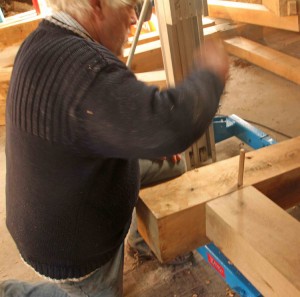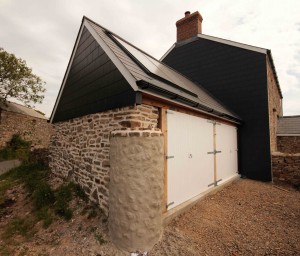Techniques
Building materials have changed hugely over the years. Modern walls are generally made of a mixture of treated softwood, bricks, blocks, damp-proof membranes and conventional cement mortars. In other words they are designed to be as water-tight as possible. In contrast older walls are designed to ‘breathe’ while internal walls move as temperatures fluctuate.
Lime mortar
 Two millennia ago the Romans discovered lime by baking limestone (calcium carbonate – CaCO3) to drive off the carbon dioxide. This makes calcium oxide (quick lime – CaO) which is then ‘slaked’ with water to create calcium hydroxide (Ca(OH)2). This resembles stiff putty, but in a relatively thin layer (e.g. as render) it absorbs atmospheric carbon dioxide to revert to limestone. The mortar is slightly porous, allowing moisture in and out of the wall. It is also ‘green’ because as it sets it reabsorbs the carbon dioxide driven off in its manufacture.
Two millennia ago the Romans discovered lime by baking limestone (calcium carbonate – CaCO3) to drive off the carbon dioxide. This makes calcium oxide (quick lime – CaO) which is then ‘slaked’ with water to create calcium hydroxide (Ca(OH)2). This resembles stiff putty, but in a relatively thin layer (e.g. as render) it absorbs atmospheric carbon dioxide to revert to limestone. The mortar is slightly porous, allowing moisture in and out of the wall. It is also ‘green’ because as it sets it reabsorbs the carbon dioxide driven off in its manufacture.
The main farmhouse and rear wall of the forge were constructed with lime and a thin ‘wash’ or render was originally applied before it was replaced with pebble dash in the 1960s.
Today the relatively sheltered south and east walls are unfinished stonework. The northern wall is rendered with lime and horsehair harvested from our own ponies. The kitchen and east extensions have a modern cement render.
 Green oak framing
Green oak framing
In the days before mechanical saws, our ancestors constructed sturdy wooden frames using soft fresh oak held together by whittled pegs. Slightly smaller diameter holes are drilled into each joint from either side. This produces an opening which is slightly curved. The peg is waxed and hammered home, squeezing the ridges tightly against the hole’s walls and the tension of being forced into a bend means it cannot be removed. This technique is most apparent in the main house. We have cut off lower peg ends for safety, but have deliberately left those higher up.
 Timber frame / breeze block
Timber frame / breeze block
The two extensions are of modern breeze block and timber frame construction. We have tried to smooth out the contrasts between old and new with the limited use of green oak and stone and roughened render finishes in the modern construction. In fact, if you look closely at the exterior wall of the games room/garden extension you will see two or three such tricks.
 Slate
Slate
Coastal houses have always been battered by wind and rain from the west. Until the 19thC protective lime renders were most common, but then railways made slate cladding readily available. After the Second World War pebbledash arrived, but although Glebe’s was already crumbling and had to be removed during renovation, the fact it was once applied indicated weather-proofing was needed, so we reverted to slate on the western wall.

